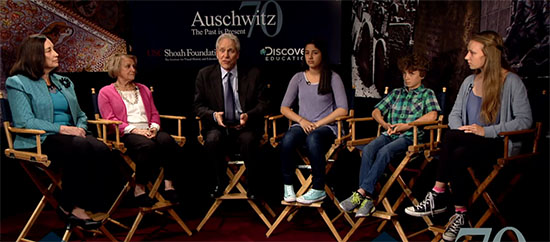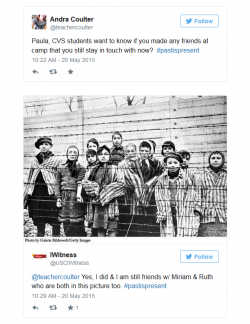Silence is Not an Option: A Lesson from Paula Lebovics
The school I teach at in Alberta, Canada, is considered a "unique setting" within our public school system. This means that our programming is designed to meet the complex learning, social and emotional needs of elementary children who exhibit extreme behavioral and emotional difficulties which impede their ability to be successful in school, community and home.
Given the emotional and social challenges my grade 5/6 students face, they often have difficulty connecting with academic material. When we began our Holocaust unit in early April it became immediately apparent that this historical event had struck a chord with my small class of boys. The stories of intolerance and inequality resonated deeply for them like nothing I had seen before; they were shocked and disgusted at the treatment of human beings against other human beings. They were also encouraged and uplifted by stories of heroes and acts of courage, however small or large the gestures were. Epic-length discussions began to take place almost daily about human nature, bullying, "what is right?", and more. Deep, reflective writing poured out of the students, a paperclip memorial was created, and memoirs were read. This group of five boys who up until then had often struggled in demonstrating empathy and kindness towards others, were now recognizing that their actions and more importantly, their voice, could have purpose in the world.
 Panelists for USC Shoah Foundation and Discovery Education's Auschwitz: The Past is Present Virtual Experience
Panelists for USC Shoah Foundation and Discovery Education's Auschwitz: The Past is Present Virtual Experience The fifty-minute broadcast was stunning, and exceptionally well-presented. Being able to see the actual locations and hear actual testimony made everything my students had been studying that much more real. Though inherently they knew it had happened, it wasn't until the Virtual Experience that it finally sank in for my students what individuals actually experienced in the Holocaust; they were no longer just stories in a book but living, breathing truths about both sides of humanity.
For them, the best part of the Virtual Experience was when they recognized the photo at the beginning as one they had studied and written photo responses about previously. When survivor Paula Lebovics was announced and began speaking, the awe and excitement in the room was palpable. My students could not believe that someone they “knew" (because by that point they felt they knew her, having studied her child image for so long already) had successfully survived and was speaking live that day.
A few days later we learned of the chance to live tweet with Paula, through USC Shoah Foundation’s IWitness Twitter account; it happened to fall on the same day we presented our Holocaust learning to the school at our monthly assembly.
On that day, Paula was kind enough to answer three of my students' questions. The experience of being able to communicate with a real-life Auschwitz survivor is something that will stay in their minds and hearts forever; more importantly, her small act emotionally "reached" a group of students who are often "unreachable"; they were over the moon with excitement.
 Our Twitter chat with survivor Paula Lebovics @USCIWitness
Our Twitter chat with survivor Paula Lebovics @USCIWitness"Our class has learned from Paula, silence is not an option. That means that we will never be silent if we see someone being put down, or bullied, or someone being intolerant of someone else. And we think you should not be silent, too. Silence is never an option, and that's what Paula taught us."
I'm truly thankful for the USC Shoah Foundation and the incredible learning journey they have taken my students on. Having access to such a resource of quality instructional materials deepens the understanding of my students, and makes experiences available that they otherwise would not have. I will be using IWitness for years to come, and will encourage others to do the same.